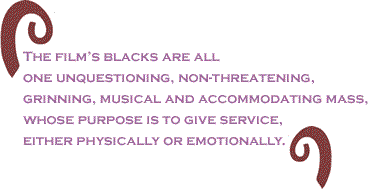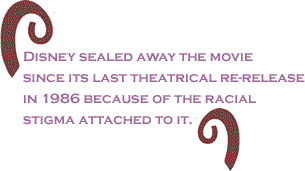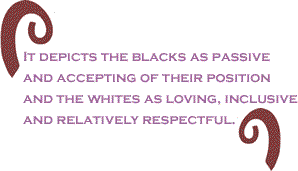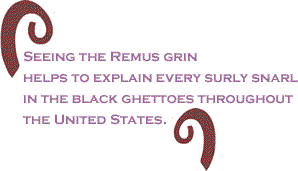
|
|||||||||||||||||||||
|
"Davy, Davy Crockett, trackin' the redskins down!" the song goes. If you want to hear the rest, buy Walt Disney's "Davy Crockett – The Complete Televised Series," DVD. The lines, and other choice lyrics like “them redskin varmints,” are from the theme music of the 1950’s show. The DVD was released in 2001. For over two decades now, Disney has been much more careful with another of their “classics” – “Song of the South.” But next year, after resting in the company vault since the 1980’s, this controversial film may be available again. Since its original, highly successful release in 1946, “Song of the South” has had and continues to have detractors. Adam Clayton Powell Jr. is reported to have called the film an “insult to American minorities.” The NAACP was highly critical of it. Movie critic Roger Ebert, while not advocating total censorship, said in his Chicago Times-Tribune column, that it should be withheld from general audiences because of the effect it could have on children. Of its own volition, Disney sealed away the movie since its last theatrical re-release in 1986 because of the racial stigma attached to it. Jim Hill, a writer specializing in Disney news, reported on his website in late March that the company plans on releasing a "Song of the South" DVD in 2006 for its 60th anniversary. But the question isn’t whether the film should be banned. The important phenomenon is the legion of incensed and activist fans (white and black) of the movie, fighting hard to have Disney release “Song of the South.” They argue that it’s only a children’s movie. They say any offensive elements the film might have can be looked past. They say Walt Disney’s intentions were good. And most importantly, they question whether the film is offensive at all.
Unequivocally, the answer is yes. No matter how benign its creators’ intentions, this film is a surreal exercise in dehumanization and dishonesty. It was excusable in 1946 because it mirrored the mainstream white outlook of the black social position in the United States – where they stood, who they should be and the conditions through which they could achieve inclusion. In 2005 however, it’s highly illuminating to observe the film’s “victimized” following battle against the forces of “political correctness” in defense of a movie that distorts reality by cleansing the cruelty out of their history. Internet movie sites and forums are filled with statements of support for the re-release. They decry “political correctness at its worst,” and the “BS of political correctness.” One fan purchased his bootleg copy of the film “from a black guy,” which “lends some irony to this whole PC business.” “Songofthesouth.net,” one of the movie’s most comprehensive fan sites, reports that more than 65,000 fans have signed a petition asking for the movie’s return. So with all this love – even among a section of blacks – what could be offensive about this film? “Song of the South” not only condones, but goes so far as to romanticize life in the South during Reconstruction. It avoids any mention of the post-Civil War terror inflicted on the blacks. It depicts the blacks as passive and accepting of their position and the whites as loving, inclusive and relatively respectful. Like a Victorian novel, everyone has his place in this paradise, no one questions it, and everyone is content. It seems an oddly Old World thematic structure. No wonder Clayton Powell is quoted as saying it was an insult “to everything America stands for.” The movie is set in the South a few years after the Civil War. Young Johnny goes with his parents to his grandmother's plantation in Georgia, apparently because there is a problem with their marriage. Johnny is distraught and Uncle Remus, one of the blacks still living on the plantation, tells him the stories of Brer Rabbit, Brer Fox, Brer Bear and Brer Frog, both to cheer him up and to teach him life lessons. Animation is used for the folktales.
The plantation is heaven. There's lots of singing, campfire storytelling, fishing and playing. The "Aunt Jemimas" make big beautiful feasts in the mansion. Undeniably there is a natural order (the young hero wears children's suits while the black children wear rags, blacks are not allowed to attend the outdoor dress parties), but everyone lives in harmony. Christian Willis, webmaster of “Songofthesouth.net,” sees Disney’s “attempt to show harmony” between races as a “big accomplishment for a film back…when segregation was still very much a part of life.” But of what value is harmony at the expense of equality, or honesty? The fictional harmony of “Song of the South” is the same as that of slavery. It is only coexistence when the blacks don’t question their position. And it’s fictional. It’s a fairy tale. For the overwhelming majority of blacks in the Southern states the situation was very different. Defenders of "Song of the South" often raise the point that the movie takes place after the end of slavery; therefore Disney was not glamorizing the slave system (unlike “Gone With the Wind”). But the Reconstruction-era South was really not much better. After the end of the Civil War, Southern whites were concerned with maintaining the social order, despite the abolition of slavery. From 1868 onward, Southern terror groups like the Klu Klux Klan carried out a brutal repression of both blacks and whites complicit in the plan to give the former slaves social and political equality. Thousands – especially prominent blacks – were whipped, beaten, mutilated and killed. The Southern political apparatus, primarily the Democratic Party, was no friend to blacks either, and in conjunction with the Klan carried out a de facto disenfranchisement through fraud and intimidation. Next for the Southern African Americans would be Jim Crow-era segregation, a system that continued well into the 20th Century (even after the movie was made). This is the utopian world in which "Song of the South" is set. As Uncle Remus says in the preamble to one of his stories, "when everything was mighty satisfactual." Defenders of the film can rightly say that it doesn’t set out to portray blacks badly. The black characters are stereotypical, but not in a mean-spirited way. Uncle Remus in particular is shown as a universally loved, sagacious elder statesman. Disney’s source material for the film was a 19th Century book by Southern author, Joel Chandler Harris, called “Uncle Remus, His Songs and Sayings.” Harris's book, extremely popular up to the mid-20th Century, is a compilation of old slave folklore tales narrated by Uncle Remus, a character representative of storytellers he knew as a child. “I do not believe that a man who spent literally his entire life immersed in the language of the African Americans could have any malicious intent towards them,” Willis says in his essay on the topic. From this then Willis assumes Walt Disney’s “innocent intent to publicize and thereby preserve the stories of the slaves.” This is only partially true. Disney also intended – as the name of the film points out – to pay homage to the South. This film is set in an ideal Southern world, and the only way this can be done is at the expense of the blacks. The African Americans in this film are beyond stereotypes – they are devices. The argument has been made that it is a children’s film, thus weighty character portrayals shouldn’t be expected. But the blacks have no character. They are all one unquestioning, non-threatening, grinning, musical and accommodating mass, whose purpose is to give service, either physically or emotionally. Johnny’s young black friend, “Toby,” serves as his guardian and fellow rascal. Remus serves as Johnny’s spiritual guide and therapist. And the black totality serves as one reassuring happy chorus broadcasting the message, “everything is satisfactual.”
One commenter on an Internet movie forum wondered why "Song of the South" is being censored while violent movies like "A Clockwork Orange" are shown. But Kubrick himself would have applauded the sinister absurdity of actor James Baskett in the role of Uncle Remus, a broad grin carved on his face as he strolls along with the animated fauna singing, "Zip-a-Dee-Doo-Dah." Baskett's grin is the worst sadism. It’s painted across his face and his face is plastered across almost all the promotional photographs for the movie. Seeing the Remus grin helps to explain every surly snarl in the black ghettoes throughout the United States. Seeing Remus’s bovine frame convulsing in an estrogen-heavy giggle (they might as well have glued a grey beard on Aunt Jemima) while he sits between Johnny and his friend Jenny, helps to explain the cartoon-like hyper machismo of oily muscles and bulletproof vests popular in Hip Hop culture. Remus is briefly relieved of the grin for the movie's moment of crisis – Johnny's mother forbids them from seeing each other. Remus is so devastated he decides to banish himself to Atlanta. Losing favor with the whites is his great tragedy, recovering their love and acceptance is his happy ending. Imagine a film about an old Jewish storyteller, living contentedly in Nazi Germany. He develops a deep bond with the grandson of the owner of the munitions factory in which he works. The sun shines brightly as he strolls along singing, back to his home in the prescribed ghetto, Star of David sewn onto his coat. No mention is made of his people’s ordeal. In fact, there is no ordeal. Such a depiction would be repellant not only to Jewish people, but to most people. The difference between the cruelty of Nazi Germany and post-slavery Southern society isn’t so much in the extent of the crime, but in the respective countries’ control over history. Defeated, Germany doesn’t get to control how even its own people view their history. Victorious, the United States still does. Nazi Germany was condemned for its crimes, but America gives itself compromise. The U.S. shows truly saint-like understanding and forgiveness when it comes to its own sins. These criticisms are not meant as an argument for censoring this film. “Song of the South’s” impact should not be overestimated. It’s really not that good a film. It’s slow and entirely without the wit of Disney’s modern films like “The Lion King.” Much of the demand is probably coming from the white backlash, proud Southerners, and those driven by nostalgia. A Buena Vista Home Entertainment (Disney’s distributor) insider interviewed by Jim Hill, said, “most kids and adults will be nodding off 30 minutes into the thing.” If re-released in 2006, Disney will most likely add explanatory content about the reality of life in the Reconstruction-era South. But the most important lesson that “Song of the South’s” rebirth will teach is the limitation of the “one America” idea. There will always be a separation between peoples when their historical realities differ. America will not condemn its past for the sake of African Americans, but even today African Americans are forced to live with the consequences of slavery, segregation and racism. Maybe inclusion shouldn’t have won out as the priority goal of the Civil Rights movement. As these unrepentant backlash forces rise, inclusion seems less and less achievable, and frankly, less attractive. For a more flattering (but more honest?) depiction of a black character, check out Dennis Haysbert’s brooding President David Palmer on the television series “24.” Despite rude skeletons like “Song of the South” in the American history closet, we have come a very long way. Hollis Henry is a second-generation American with roots in Trinidad, where he has lived and worked as a journalist. He is pursuing a Masters degree in Journalism at New York University. Contact him at [email protected]. |
Your comments are always welcome. Visit the Contact Us page to send e-Mail or Feedback or Click here to send e-Mail to [email protected] e-Mail re-print notice
If you send us an e-Mail message we may publish all or part of it, unless you tell us it is not for publication. You may also request that we withhold your name. Thank you very much for your readership. |
| May 19 2005 Issue 139 |
|||||||||
|
|||||||||
|
|
|||||||||
| Printer Friendly Version | |||||||||
 |
|||||||||
 |
|||||||||
| |
|||||||||
| |
|||||||||




























